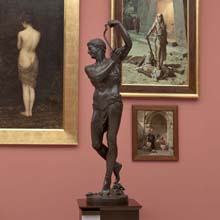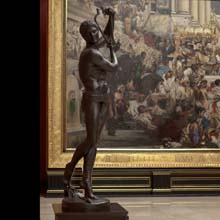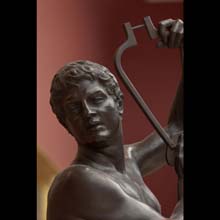


material: bronze
dimensions: 205 × 63 × 60 cm
description: Sclavus saltans is a full-size bronze sculpture of a life-size young slave, portrayed in a dancing pose, holding a lyre raised upwards. His legs are arranged in a dance-like manner, a mask is lying next to them. Following the academic fashion effectively, Weloński “dressed up” the subject of his sculpture in a classical costume, thus rendering the atmosphere of the epoch in a meaningful way. A slave should carry out the orders of his lord and master, obey him and, if necessary, provide entertainment. He is supposed to entertain, please his public, in this case also accompanying himself. It seems that the artist aimed at dramatic association of the lively pace of dancing with the compulsion under which the slave does it. What we can see here is a means of conveying emotions and the drama of feelings of all kinds. The sculptor employed the motif of dance to show the idealized human body of perfect proportions, modelled in accordance with academic patterns, in a dancing pose. The dancing slave appears as an allegory of the oppressed Polish nation, living at the bidding of the partitioners, one might say, “dancing to their tune.” Just as the existence of the Polish nation under the partitioners was a period of determination to keep up the national spirit and to fight with the oppressors – first in uprisings and, after their fall, to “struggle” in the field of education, in the era of positivism literature and art also abounded in references to Polish national pride. There were also a number of works reprimanding Poles for the gradual losing of the national unity and high self-esteem or even for subservient gestures to the oppressors. Anna Budzałek
exposition: The Gallery of 19th Century Polish Art in Sukiennice,
The Cloth Hall, 1, Main Market Square
key: Around the academy >>>
dimensions: 205 × 63 × 60 cm
description: Sclavus saltans is a full-size bronze sculpture of a life-size young slave, portrayed in a dancing pose, holding a lyre raised upwards. His legs are arranged in a dance-like manner, a mask is lying next to them. Following the academic fashion effectively, Weloński “dressed up” the subject of his sculpture in a classical costume, thus rendering the atmosphere of the epoch in a meaningful way. A slave should carry out the orders of his lord and master, obey him and, if necessary, provide entertainment. He is supposed to entertain, please his public, in this case also accompanying himself. It seems that the artist aimed at dramatic association of the lively pace of dancing with the compulsion under which the slave does it. What we can see here is a means of conveying emotions and the drama of feelings of all kinds. The sculptor employed the motif of dance to show the idealized human body of perfect proportions, modelled in accordance with academic patterns, in a dancing pose. The dancing slave appears as an allegory of the oppressed Polish nation, living at the bidding of the partitioners, one might say, “dancing to their tune.” Just as the existence of the Polish nation under the partitioners was a period of determination to keep up the national spirit and to fight with the oppressors – first in uprisings and, after their fall, to “struggle” in the field of education, in the era of positivism literature and art also abounded in references to Polish national pride. There were also a number of works reprimanding Poles for the gradual losing of the national unity and high self-esteem or even for subservient gestures to the oppressors. Anna Budzałek
exposition: The Gallery of 19th Century Polish Art in Sukiennice,
The Cloth Hall, 1, Main Market Square
key: Around the academy >>>












